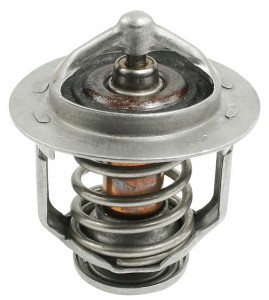 In automotive cooling systems, a mixture of water and antifreeze circulates from the bottom of the radiator up the lower radiator hose to the water pump, which pushes it through the water passages in the cylinder block to absorb heat and keep cylinder bores and pistons from overheating. The water then moves up to the cylinder head, circulates around the valves, absorbs more heat, and then passes out of the cylinder head through the open thermostat into the upper radiator hose and back to the radiator, where the radiator fan and the motion of the car create an air flow to cool the hot water/antifreeze coolant as it flows down to the bottom of the radiator, where the cycle begins again.
In automotive cooling systems, a mixture of water and antifreeze circulates from the bottom of the radiator up the lower radiator hose to the water pump, which pushes it through the water passages in the cylinder block to absorb heat and keep cylinder bores and pistons from overheating. The water then moves up to the cylinder head, circulates around the valves, absorbs more heat, and then passes out of the cylinder head through the open thermostat into the upper radiator hose and back to the radiator, where the radiator fan and the motion of the car create an air flow to cool the hot water/antifreeze coolant as it flows down to the bottom of the radiator, where the cycle begins again.
The automotive thermostat has a spring-loaded valve that regulates coolant flow around the engine to maintain proper operating temperature for minimal engine wear and adequate heater output to keep car occupants warm and comfortable in cold weather. The thermostat valve is closed when the engine is not in operation. To allow the engine to warm up quickly after cold starting, the valve remains closed until coolant temperature warmed by engine heat reaches a certain level, at which the valve opens so the coolant can flow around the engine block and remove excess heat before it can build up to where it risks overheating that might cause engine damage.
Thermostats have rated temperatures at which they open depending on vehicle brand and model. Temperature ratings are important for computers and vacuum switches that sense and monitor coolant temperature to control fuel mixtures, ignition timing, and exhaust gas recirculation. A thermostat of the wrong rated temperature for the car may keep the coolant too cool to activate such controls or too hot to protect the engine.
For work on any part of the engine cooling system the car should be on level ground, and the engine should be cool. Begin by removing the radiator cap by depressing and twisting it counter-clockwise. If the engine has been running, turn the cap only slightly, not fully, to allow the steam pressure in the system to escape before full removal. Drain the system by removing the drain tap or plug at the base of the radiator and on the engine block if fitted. When flushing and cleaning the radiator and cooling system, complete this task before changing the thermostat.
The thermostat location varies with the car brand and model but as a rule is in the engine water outlet to the upper radiator hose. A very few brands may place it in the water outlet to the radiator bottom hose. Follow the radiator hose, locate the water outlet from the engine, and the thermostat is very likely to be there. Loosen the radiator hose clamp at the thermostat housing and twist the hose to remove it. A considerable amount of coolant may pour from the hose when removed.
Loosen the thermostat housing bolts with a ratchet socket or open-ended wrench, lift the housing cover, and pull out the thermostat. Note the thermostat position in the housing and be sure to insert the replacement part in the same way. The copper heat-sensing element of the new thermostat should face toward the engine. If not, it won’t work properly.
Clean the thermostat housing with a putty knife or scraper to remove old gasket and glue remains. Be careful with aluminum housings as the soft metal scratches easily. Apply a new gasket, replace the housing cover, and tighten the housing bolts evenly to manufacturer-recommended torque settings. Re-attach the radiator hose to the outlet on the engine, re-insert the radiator and engine block drain taps or plugs, and refill the system at the radiator filler with coolant of correct water and antifreeze proportions. Start the engine and check for coolant return from full circulation through the top hose to the radiator.
Two common problems with thermostats are when they remain open or closed at all times. The former problem is by far the less undesirable. It causes engine coolant to circulate through the radiator all the time as if there were no thermostat. To check for a thermostat stuck open, when the engine is cold remove the radiator cap, start the engine, and see right away whether the coolant flows from the top hose into the radiator. If so, it is likely that the thermostat is open all the time.
The more undesirable problem, that of the thermostat stuck closed, is dangerous because it can cause the engine to overheat quickly with unfortunate effect. To detect a thermostat stuck closed, start the engine and watch the temperature gauge. If it climbs to 3/4 and the coolant in the radiator remains unheated, stop the engine immediately and check the coolant level. A thermostat may not open if the coolant level is low because the thermostatic spring operates in reaction to coolant temperature, which may not reach the spring if the level is low, and the thermostat may remain closed even with an engine overheating. If coolant level is sufficient, the fault is in the thermostat, which must be replaced as repair of this inexpensive item is not feasible.
